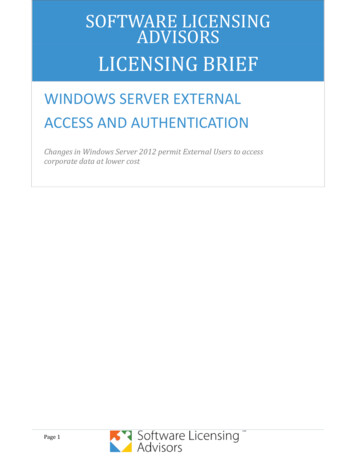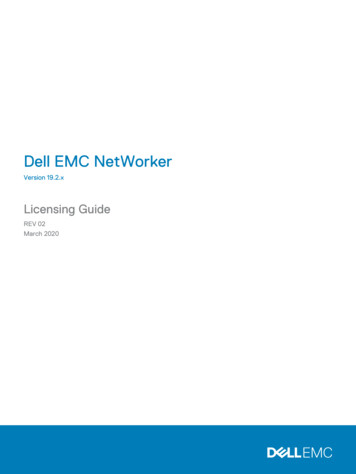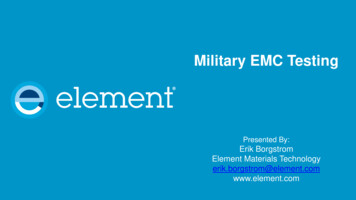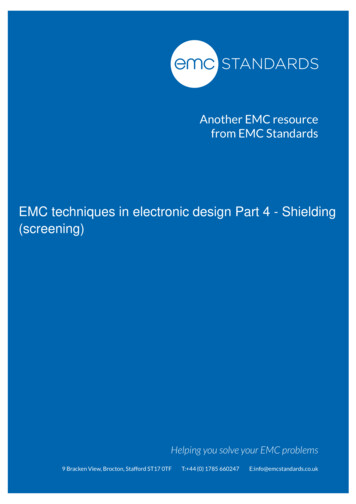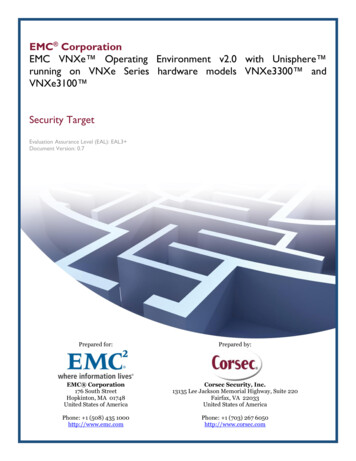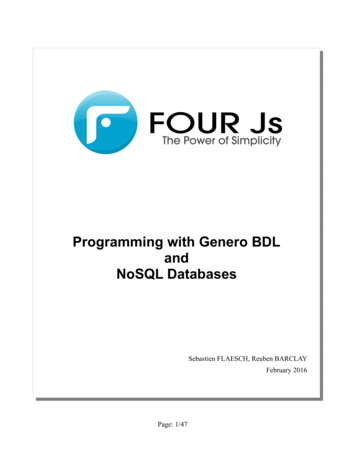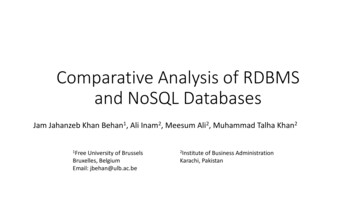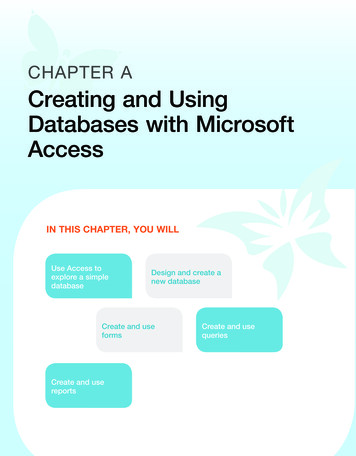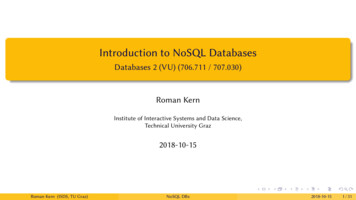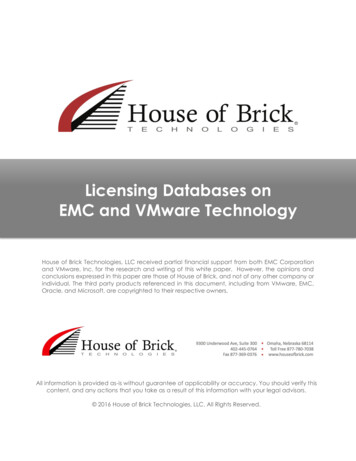
Transcription
Licensing Databases onEMC and VMware TechnologyHouse of Brick Technologies, LLC received partial financial support from both EMC Corporationand VMware, Inc. for the research and writing of this white paper. However, the opinions andconclusions expressed in this paper are those of House of Brick, and not of any other company orindividual. The third party products referenced in this document, including from VMware, EMC,Oracle, and Microsoft, are copyrighted to their respective owners.All information is provided as-is without guarantee of applicability or accuracy. You should verify thiscontent, and any actions that you take as a result of this information with your legal advisors. 2016 House of Brick Technologies, LLC. All Rights Reserved.
Licensing Databases on EMC and VMware TechnologyTable of Contents12Understanding Licensing is Critical to Your Organization . 51.1Cost . 51.2Complexity . 51.3Value to Organizational Success . 5RDBMS Licensing Basics . 72.1PostgreSQL and EnterpriseDB . 82.1.1PostgreSQL . 82.1.2EnterpriseDB. 82.1.3Storage Choices . 92.2Microsoft SQL Server . 92.2.1Microsoft Documents . 92.2.2Special Organizations. 92.2.3Editions of SQL Server . 92.2.4Licensing Methods . 102.2.5Software Assurance . 102.2.6Virtual Rights . 102.2.7Hyper Threading . 102.2.8Storage Choices . 112.3MySQL and Mariah DB . 112.4Oracle. 112.4.1Oracle Documents . 112.4.2Common Assertions that Are Not Contractually Binding . 132.4.3Special Organizations. 142.4.4Editions of Oracle . 142.4.5Oracle Licensing Metrics. 142.4.6Definition of Processor . 142.4.7Processor Licensing . 162.4.8Oracle Editions: Enterprise vs. Standard . 192.4.9Replacing Oracle Features with EMC and VMware Solutions . 212.4.10Storage Choices . 232.4.11Oracle Support . 232.4.12Virtual Rights . 242.4.13Hyper Threading . 242.5Third-Party Licensing Considerations for vSphere . 242.5.1Oracle Licensing Strategies . 25 2016 House of Brick Technologies, LLCPage 2
Licensing Databases on EMC and VMware Technology3RDBMS Licensing for EMC Hardware . 273.1Compute Selection. 273.1.1Processor/Socket Counts . 273.1.2RDBMS Hardware Licensing Examples . 283.1.3Licensing Matrix – Oracle Enterprise . 283.1.4Licensing Matrix – Microsoft SQL Server Enterprise . 293.1.5Licensing Matrix – License Cost Comparison . 293.2Storage Selection . 303.2.1Assumptions . 303.2.2Fully Automated Storage Tiering (FAST) Cache . 303.2.3Fully Automated Storage Tiering for Virtual Pools (FAST VP) . 313.2.4All-Flash / XtremIO . 313.2.5VMAX3. 323.2.6ScaleIO . 323.3Converged Architectures . 333.3.13.44Vblock/VxBlock . 33Hyper-Converged Architectures . 333.4.1VxRack . 333.4.2VxRail . 35RDBMS Licensing for VMware and EMC Features . 364.1VMware is the Best Choice for Database Infrastructure . 364.1.1VMware High Availability (vSphere HA) . 374.1.2vSphere Distributed Resource Scheduler (DRS) . 374.1.3VSAN . 384.1.4vSphere/ESXi CPU Affinity . 394.2Storage Replication . 414.2.1SAN Tooling (SRDF/Recover Point) . 414.2.2vSphere Replication Service (vRS) . 424.2.3Oracle Data Guard . 424.2.4Standby Database . 424.3Disaster Recovery (DR) . 424.3.1Oracle OLSA Versions Prior to Q4-2007 Template . 434.3.2vSphere Site Recovery Manager (SRM) . 434.3.3Sample DR Architecture . 445Appendix A: Host Affinity Rules . 456Appendix B: Anti-Affinity Rules . 49 2016 House of Brick Technologies, LLCPage 3
Licensing Databases on EMC and VMware TechnologyTable of FiguresFigure 1: IT Budget Allocation . 5Figure 2: Oracle Documents Contractual or Not. 12Figure 3: Oracle Licensing Common Assertions . 13Figure 4: Oracle Parking Garage . 16Figure 5: Alternative DR Setup . 22Figure 6: Oracle Enterprise Licensing Matrix . 28Figure 7: SQL Server Enterprise Licensing Matrix . 29Figure 8: Compare RDBMS Costs Across Platforms . 29Figure 9: VxRack Configurations . 34Figure 10: VxRail Configurations . 35Figure 11: Advantages of VMware for RDBMS . 36Figure 12: DR Configuration to Limit License Costs . 44Figure A.1 DRS Group Manager . 45Figure A.2 Database Host Designation. 46Figure A.3 Add Host Group . 46Figure A.4 Add VM DRS. 47Figure A.5 Add a Rule . 47Figure A.6 Add Host Affinity Rule . 48Figure A.7 Add the Rule . 48Figure B.1 VM Anti-affinity Set-up . 49Figure B.2 Add a Rule on vSphere DRS . 50Figure B.3 Add VM to the Rule . 50Figure B.4 Click Add . 51Figure B.5 Save Rule Change . 51 2016 House of Brick Technologies, LLCPage 4
Licensing Databases on EMC and VMware Technology1Understanding Licensing is Critical to Your OrganizationUnderlying most systems, which are critical to an organization’s operational success is aRelational Database Management System (RDBMS). While there are alternatives to RDBMS thatare emerging, the vast majority of the world’s information transactions and interactions useRDBMS technology. Why is understanding database licensing so important to mostorganizations? There are several compelling reasons that we have developed over the years ofsuccessfully helping customers at House of Brick (HoB). These reasons include:1.1 Cost, Complexity, and Value to Organizational Success.CostThe bottom line is that software is expensive. This isespecially true for those critical applications that driveyour businesses and organizations. As illustrated in thischart based on data gathered by Wikibon.com, softwarelicenses and support represent the single largest line itemin the typical IT budget. The cost of software is greaterthan the servers, storage, and network (serverinfrastructure) used to run those programs.We have seen far too many customers who did notadequately understand their licensing obligations andrequirements, and ended up costing their organizationsmany millions of dollars in unnecessary expense.1.2Figure 1: IT Budget AllocationEnd-UserCompu ng9%ServerInfrastructure17%Facili es7%So ware Licenses& Support25%IT BudgetAllocationOpera ons &Management20%Developmentfor So ware22%ComplexityIn addition to being the single biggest expense that most organizations have, softwareprograms, especially for business/mission critical databases and applications can be verycomplex to manage effectively. Database administration, for example, requires well-trained,and experienced individuals to keep the systems running optimally and consistently. They needto understand the implications of high availability, disaster recovery, patching, performanceanalysis/tuning, system health, provisioning, and validation, as well as to a minimal degree ofcompetency - licensing. Missing any of these elements will keep the organization from receivingthe full benefit of their software investment.1.3Value to Organizational SuccessYou might wonder why people go to so much cost and hassle to acquire and use thesesoftware programs. The answer is that they provide critical value to the organization’s operationsand success. We like to define mission critical applications in terms of career impact. Forexample if a mission critical system has severe problems, someone could be at risk of losing theirjob. These systems keep the organization performing its charter, and bring in the revenuerequired for ongoing operations. When a business has a critical system go down, that business isnot just inconvenienced, it loses money. Depending on the severity and duration of thedowntime, it could even threaten the company’s existence. 2016 House of Brick Technologies, LLCPage 5
Licensing Databases on EMC and VMware TechnologyOrganizations need the technology that Oracle, Microsoft, and others provide in order to runthese critical functions. For the reasons outlined above, understanding the complexities oflicensing this technology is critical. This document will focus on key aspects of databaselicensing, with the following goals:1. Maximize the benefit of virtualization and cloud technologies to create flexibility,availability, and recoverability, while shortening the time to develop and prove new,critical features and functions.2. Create an environment that minimizes the licensing footprint within the scope of thesebenefits.3. Decipher the misinformation that is being perpetuated throughout the industry related tolicensing databases, especially when it comes to virtualization and cloud computing.4. Demonstrate how solutions from EMC and VMware can create the optimum balancebetween operational and performance excellence, while controlling the impact ofRDBMS licensing. 2016 House of Brick Technologies, LLCPage 6
Licensing Databases on EMC and VMware Technology2RDBMS Licensing BasicsRelational Database Management System (RDBMS) software vendors understandably want toprofit from their investment in software development, and we inherently recognize value whenusing that software. For this reason, commercial products usually require monetaryconsideration in exchange for a license to use the software as it relates to any given hardwareconfiguration or software feature set. There are exceptions to this model, notably in the opensource community. However, even in those cases there is a license that is agreed to simplythrough use of the software. With software licenses, there are terms associated with the licensegrant. It is very important to understand the terms of these agreements and to comply with themwhen using the software.For commercial ventures, there is usually a profit motive to maximize revenue based on grantinglicenses to use the software. In addition, the commercial entity almost always desires to establishan ongoing revenue stream in the form of an optional support or maintenance agreement,which is usually integrated into the license agreement. These two agreements often becomeintertwined, and as the licensed product matures, the relationship between license and supportcan become increasingly complex.In this section, we will provide an overview of licensing concepts and considerations for severalpopular RDBMS programs including:1. PostgreSQL and EnterpriseDB (EDB)2. Microsoft SQL Server3. MySQL and Mariah DB4. Oracle 2016 House of Brick Technologies, LLCPage 7
Licensing Databases on EMC and VMware Technology2.1PostgreSQL and EnterpriseDB2.1.1PostgreSQLPostgreSQL has one of the simplest licenses in existence for enterprise-ready RDBMS software. Infact, it’s so simple it can be included in its entirety in this e):Permission to use, copy, modify, and distribute this software and its documentation for any purpose,without fee, and without a written agreement is hereby granted, provided that the above copyrightnotice and this paragraph and the following two paragraphs appear i
Licensing Databases on EMC and VMware Technology House of Brick Technologies, LLC rec
